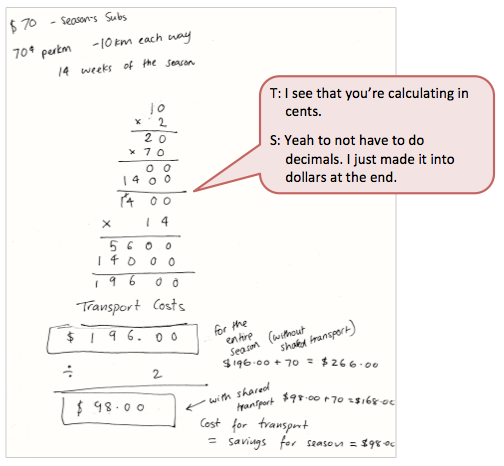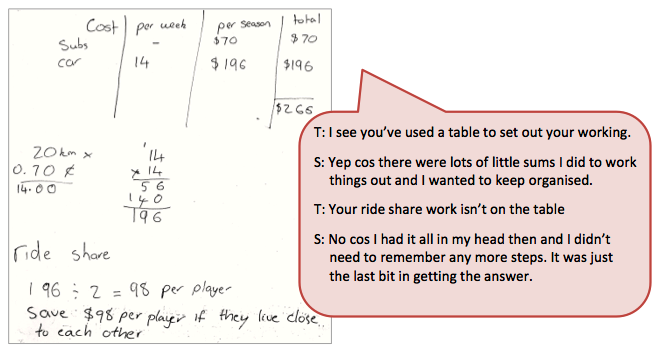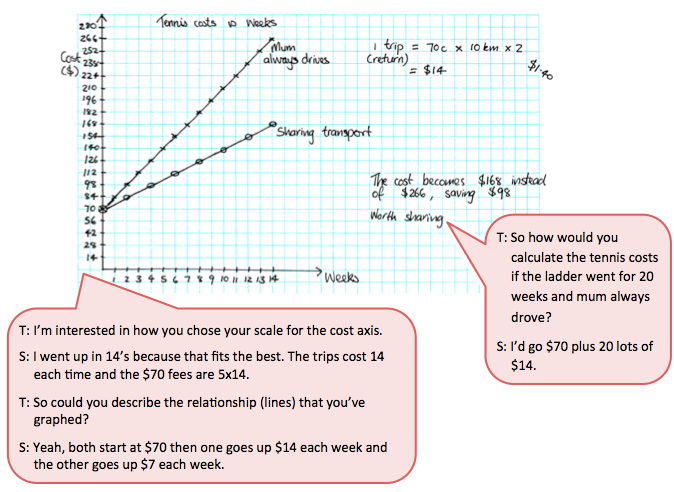Tennis costs
The purpose of this activity is to engage students in using arithmetic and pre-algebra techniques to solve a financial problem.
This activity assumes the students have experience in the following areas:
- Expressing money amounts as decimals and calculating with money.
- Expressing relationships between quantities as rates.
- Calculating costs using rates and ratios.
The problem is sufficiently open ended to allow the students freedom of choice in their approach. It may be scaffolded with guidance that leads to a solution, and/or the students might be given the opportunity to solve the problem independently.
The example responses at the end of the resource give an indication of the kind of response to expect from students who approach the problem in particular ways.
 Charlie plays tennis, with one ladder competition day each week.
Charlie plays tennis, with one ladder competition day each week.
It costs $70 for the season’s subs and his mother drives him the 10 km each way to the tennis club (running costs for the car are 70 cents per km).
If the season runs for 14 weeks, what is the cost of competing in this tennis club ladder?
If he finds a way to share transport with another player (so his Mother only needs to take him every second week), what would the cost for the season become?
Are the savings worthwhile?
The following prompts illustrate how this activity can be structured around the phases of the Mathematics Investigation Cycle.
Make sense
Introduce the problem. Allow students time to read it and discuss in pairs or small groups.
- Do I understand the situation? (Students may need background information about finding total costs by multiplying with unit rates.)
- What is cost? How do you work them out? Which costs are fixed and what cost vary?
- What information has been given and what more information might be needed?
- Can I anticipate what the total cost will be? Can I anticipate the cost difference if transport is shared?
- Does this look/sound like a problem I have worked on before? What kind of problem is this?
- What will the answer look like? (A total cost for the 14 weeks and a cost with shared transport factored in. The costs are supported by clear working.)
Plan approach
Discuss ideas about how to solve the problem. Emphasise that, in the planning phase, you want students to say how they would solve the problem, not to actually solve it.
- What are the maths skills I need to work this out? (Rates are integral to the problem.)
- How could I show this problem using numbers, equations, pictures, graphs, tables, or materials? (A ratio table is a good strategy to use.)
- What strategies can I use to get started?
- How much change in the total cost is shared transport likely to cause? How do you know? Can I make an estimate?
- What tools (digital or physical) could help my investigation?
Take action
Allow students time to work through their strategy and find a solution to the problem.
- Have I shown my workings in a clear, systematic way?
- Does my answer seem correct? Is it close to my estimation?
- How could I make sure that I haven’t missed anything?
- Do the costs seem reasonable? Is sharing transport worthwhile? Is there a downside to sharing transport?
- Do my results look to same or different to others? Why could this be?
- Is there another possible answer or way to solve the problem that is more efficient?
Convince yourself and others
Allow students time to check their answers and then either have them pair share with other groups or ask for volunteers to share their solution with the class.
- What is the cost difference between full and shared transport?
- Have I shown clearly how the costs were found?
- How would I convince someone else that my calculations are correct?
- Is there some mathematics that I need to learn?
- What does my answer mean for people who want to share transport costs?
Examples of work
Work Sample 1
The student calculates with rates using multiplication and adds on the fixed cost of tennis subscription to find a total cost and calculates the difference between full and part transport costs.
Click on the image to enlarge it. Click again to close. 

Work Sample 2
The student represents the situations as linear relationships. He/She use a graph to compare the cost of the full and part transport options.
